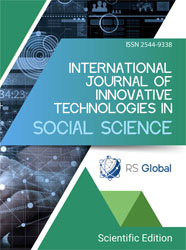THE IMPORTANCE OF DRY PORT IN THE ORGANISATION OF URBAN SPACE AND THE OPTIMISATION OF PORT ACTIVITY: A CASE STUDY OF THE CITY OF SKIKDA
Abstract
Dry ports are essential for efficient maritime port operations and can contribute to economic growth. Skikda, a city on the Mediterranean coast, is a significant hub for international trade and transportation, with its port playing a significant role in the country's economy. However, the closure of Skikda's dry port has had negative consequences on the city and the region, leading to job losses, reduced port efficiency, and hindered local business growth. Dry ports are essential for efficient logistics operations, improving connectivity, reducing transportation costs, and creating jobs. A comprehensive logistics strategy is essential to address the challenges faced by Algerian ports, particularly through the development of dry ports and supporting infrastructure. This strategy should evaluate the economic impact of dry port closures, the potential benefits of reopening facilities like Skikda's dry port, and their role in multimodal transportation. Additionally, it should consider the effects of globalization and containerization on port operations, as well as the specific challenges Algerian ports face, such as aging infrastructure and bureaucratic inefficiencies. Reopening Skikda's dry port could yield significant benefits, including job creation, improved logistics, and economic growth.
References
Yanis, I., & Edine, B. A. (s.d.). Conflicts of use city-port: Causes of informal habitat proliferation. Case of the port city of Bejaia (Algeria). ASJP. Available on cerist.dz
Cherfi, Z., & Chemloul, M. (2022). Measuring the performance of port activities through efficiency and effectiveness: Case of the Algiers port company. Dspace. Available on ummto.dz
Rouquet, A., & Guenoun, M. (2023). Logistisons l’Etat! : Proposals to strengthen the logistics organization of France. Logistics & Management. Taylor & Francis.
Notteboom, T. E., & Rodrigue, J.-P. (2005). Port regionalization: Towards a new phase in port development. Maritime Policy & Management, 32(4), 297–313.
Lacoste, R., & Terrassier, N. (n.d.). Container port handling: Global players' perspectives - a European vision.
Mupier Muka, N. (2024). Optimisation of the strategic and operational management of the Congolese maritime line SA, a public commercial undertaking in the Democratic Republic of the Congo. Matheo. Available on uliege.beCerceau,
J., & Enrech, C. (2023). Interoperability and resilience of cross-border territories along logistics corridors. IMT Mines Alès. Available on hal.science Padonou, V. A. (2022).
Port logistics and accessibility of the landlocked countries of the WAEMU to the international market: Case of the port of Cotonou. Available on hal.science Granier, C., & Ellie, P. (2021). These territories seeking to reindustrialize. The Factory. Available on la-fabrique.frAzzedine
M. A., Amar, M. A., & Souhila, M. (n.d.). Option: Finance and Accounting. Available on theses-algerie.comMottet, É. (n.d.). La BRI en Asie du Sud-Est. De Gruyter. Disponible sur degruyter.com
Law no. 07-79 of 21 July 1979 on the Customs Code, as amended and supplemented by various laws and ordinances. Hiliquin, M. (2024, December). New Silk Roads in Central Asia in China’s geo-economic strategy. Geoconfluences.
Claverie, B. (2024, September). The dry port of Xi'an: A logistic arrangement between local development and China’s insertion in globalization. Geoconfluences.Shaaban, A. (2015). Dry ports : Egypt's path to development. Sky Shaaban, 14, 20p.
Benkhedda, K., El Hakmi, S., & Bennaceur, A. (2023). The determinants of port logistics performance: Case of the port of Casablanca.. International Journal of Accounting, Finance, Auditing, Management and Economics, 4(1-2), 81–100. https://doi.org/10.5281/zenodo.7582300
Merzoug, S. (2013). Littoral without maritime: Obstacle to external trade. Les Cahiers du Cedimes, 7(2), 44. Alilat, T. (2005). The challenges of containerization in Algerian ports (Mémoire de magistère, Université Abderrahmane Mira, Bejaia).
Mohamed Chérif, F.-Z. (2004). The Port and Maritime Activity of Algeria: Problems and Prospects (2nd ed.). Office for Academic Publications.
Lamour, C. (2011). Grand-régionalisme: From partial state decompartmentalization to network territoriality. Geographica Helvetica, 66(4), 281–292. https://doi.org/10.5194/gh-66-281-2011
Skikda Port Company. (2020). Guide to Skikda Ports (Ed. 3). Skikda Port Company.
Skikda Port Company. (2018). Statistical Yearbook 2018. Skikda Port Company. Available at https://skikda-port.com/wp-content/uploads/2022/03/Annuaire-Statistique-2018.pdf
Skikda Port Company. (2020). Statistical Yearbook 2018. Skikda Port Company. Available at https://skikda-port.com/wp-content/uploads/2022/03/Annuaire-Statistique-2020.pdf
Ourida, E., & Ali, A. (2021). The reality of strategic management in shipping services: A case study of Algeria. Journal of New Economy, 12(1), 644–663. Published on March 20, 2020; Accepted on January 1, 2021.
Agence Nationale d'Intermédiation et de Régulation Foncière. (2020). Monograph: Wilaya de Skikda. Agence Nationale d'Intermédiation et de Régulation Foncière.Boison, D. K., & Antwi-Boampong, A. (2020).
Blockchain ready port supply chain using distributed ledger. Journal of NBICT, 1(1), 1–32. https://doi.org/10.13052/nbjict1902-097X.2020.001
Views:
168
Downloads:
122
Copyright (c) 2025 Amiour Amel, Boulehouche Allaoua

This work is licensed under a Creative Commons Attribution 4.0 International License.
All articles are published in open-access and licensed under a Creative Commons Attribution 4.0 International License (CC BY 4.0). Hence, authors retain copyright to the content of the articles.
CC BY 4.0 License allows content to be copied, adapted, displayed, distributed, re-published or otherwise re-used for any purpose including for adaptation and commercial use provided the content is attributed.











